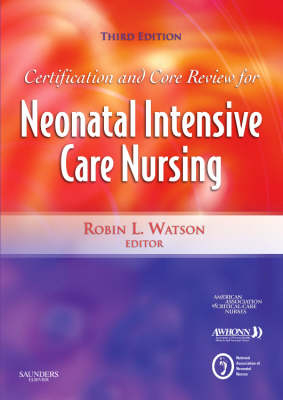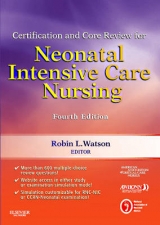
Certification and Core Review for Neonatal Intensive Care Nursing
Saunders (Verlag)
978-1-4160-3667-8 (ISBN)
- Titel erscheint in neuer Auflage
- Artikel merken
The new edition of this powerful review tool helps readers to assess and build their knowledge of the information covered in "AWHONN, AACN, and NANN: Core Curriculum for Neonatal Intensive Care Nursing, 3e". The review book is also authored by AACN (American Association of Critical-Care Nurses), AWHONN (Association of Women's Health, Obstetric, and Neonatal Nurses), and NANN (National Association of Neonatal Nurses) and is a companion to the Core Curriculum. The Core Review includes 600 multiple-choice study questions to challenge readers' mastery of all the essential knowledge in the field. Written under the authority of the American Association for Critical-Care Nurses (AACN) and reviewed by the Association of Women's Health, Obstetric, and Neonatal Nurses (AWHONN) and the National Association of Neonatal Nurses (NANN), it is an ideal study tool to facilitate preparation for neonatal critical-care nursing certification.
Section I: General Assessment and Management Chapter 1. Assessment of Fetal Well Being (10) Significance of findings -Alpha-fetoprotein -Biophysical profile -Diagnostic ultrasound -Lung maturation studies Recognize neonatal significance of fetal heart rate patterns -Altered variability -Decelerations -Tachycardia, bradycardia Effects of maternal medications on fetus/neonate -Tocolytics -Analgesia, anesthesia Impact of methods of delivery mode on neonate Chapter 2. Adaptation to Extrauterine Life (11) Transitional circulation Routine care considerations Recognition of the sick newborn Chapter 3. Neonatal Resuscitation (10) AHA/AAP guidelines for neonatal resuscitation -Initial evaluation -Indications for ventilation -Indications for intubation -Indications for compressions -Resuscitation of the infant born through meconium stained amniotic fluid -Indication for chest compressions -Use of resuscitation medications: epinephrine, volume expanders, sodium bicarbonate Resuscitation of the neonate with -Diaphragmatic hernia -Hydrops fetalis -Perinatal asphyxia -Upper airway obstruction Chapter 4. Physical Assessment (42) General appearance Head Eyes, ears, nose and throat Neck Chest Abdomen Genitalia Extremities Spine/back Skin Neuromuscular and reflexes Chapter 5. Gestational Age Assessment (32) Interpretation of growth curves Physical and neuromuscular characteristics -Preterm -Term -Postterm -SGA -AGA -LGA Associated risks with -Preterm -Postterm -SGA -LGA Chapter 6. Thermoregulation (21) Mechanisms of heat loss and production Maintaining a neurtralthermal environment Management of thermoregulation problems Equipment -Incubators: servo controlled vs non-servo controlled -Radiant warmers Chapter 7. Fluid and Electrolytes (21) Normal fluid and electrolyte requirements Monitoring fluid and electrolyte status Chapter 8. Nutrition Management (21) Nutritional requirements Enteral feeding -Minimal enteral feeding -Gavage feeding -Bottle feeding -Breast feeding Parenteral nutrition -Indications -Composition -Complications Dietary supplements -Breast milk fortifiers -Glucose polymers -Iron -MCT oil -Vitamins Chapter 9. Developmental Support (21) Neurobehavioral development Stability and stress signals Impact of the NICU environment Intervention strategies -Reducing noise levels -Reducing light levels/diurnal patterns -Altering care patterns -Handling -Positioning -Kangaroo care -Non-nutritive sucking -Provision of sensory experiences Chapter 10. Radiographic Evaluation (11) Xray views commonly used in newborns Radiographic densities Indwelling lines and tubes Radiographic features of common newborn diseases/defects/conditions Chapter 11. Pharmacology (10) Priniciples of neonatal pharmacology -Administration methods/issues -Absorption from GI tract, skin, muscle -Serum drug levels (toxic vs therapeutic) -Drug distribution in the body -Drug excretion -Drug incompatibilities Dosage calculations Common drugs Safety issues Section II: Pathophysiology Chapter 12. Pulmonary Disorders (99) System wide knowledge (assessment and monitoring) -Anatomy and physiology -Maturational anatomy and physiology -Invasive, non-invasive diagnostic studies -Relevant pharmacology -Implications of system failure on other systems -Respiratory monitoring: pulse oximeter, transcutaneous O2/CO2, end tidal CO2 Respiratory infections Respiratory distress syndrome Transient tachypnea of the newborn Apnea of prematurity Persistent pulmonary hypertension of the newborn Aspiration pneumonia Meconium aspiration Pulmonary hemorrhage Air leaks Bronchopulmonary dysplasia Diaphragmatic hernia Choanal atresia Pulmonary hypoplasia Vocal cord paralysis Phrenic nerve palsy/damage Surfactant administration Chest tubes and drainage systems Endotracheal intubation Entotracheal tube suctioning Mechanical ventilation: cpap, conventional ventilation, high frequency Chapter 13. Cardiovascular Disorders (58) System wide knowledge (assessment and monitoring) -Anatomy and physiology -Maturational anatomy and physiology -Invasive, non-invasive diagnostic studies -Relevant pharmacology -Implications of system failure on other systems -EKG monitoring -Hemodynamic monitoring Congenital heart defect Congestive heart failure/pulmonary edema Rhythm disturbances, conduction system defects Shock (hypovolemic, cardiogenic, distributive) Hypertension Tamponade Chapter 14. Gastrointestinal Disorders (26) System wide knowledge (assessment and monitoring) -Anatomy and physiology -Maturational anatomy and physiology (includes GER, TPN complications) -Invasive, non-invasive diagnostic studies -Relevant pharmacology -Implications of system failure on other systems Tracheoesophageal fistula Omphalocele/gastroschisis Malrotation/Volvulus Necrotizing enterocolitis Short bowel syndrome Meconium ileus Meconium plug Intestinal obstructions (duodenal, jejunal, ileal, imperforate anus) Gastroesophageal reflux Chapter 15. Metabolic/Endocrine Disorders (17) System wide knowledge (assessment and monitoring) -Anatomy and physiology -Maturational anatomy and physiology -Invasive, non-invasive diagnostic studies -Relevant pharmacology -Implications of system failure on other systems Inborn errors of metabolism / Newborn screening Infants of diabetic mothers Hypoglycemia/hyperglycemia Hypocalcemia/hypercalcemia Rickets Hypothyroidism/hyperthyroidism Chapter 16. Hematologic Disorders (17) System wide knowledge (assessment and monitoring) -Anatomy and physiology -Maturational anatomy and physiology -Invasive, non-invasive diagnostic studies -Relevant pharmacology -Implications of system failure on other systems Hyperbilirubinemia DIC Idiopathic thrombocytopenia purpura Rh incompatibilities/ABO incompatibilities Anemia Polycythemia/hyperviscosity Hydrops fetalis Chapter 17. Neurologic Disorders (22) System wide knowledge (assessment and monitoring) -Anatomy and physiology -Maturational anatomy and physiology -Invasive, non-invasive diagnostic studies -Relevant pharmacology -Implications of system failure on other systems -Signs of increased ICP -Ventricular reservoirs/shunt Birth injuries Hydrocephalus Intracranial hemorrhage Periventricular leukomalacia Hypoxic ischemic encephalopathy Neural tube defects Seizures Chapter 18. Renal and Genitourinary Disorders (10) System wide knowledge (assessment and monitoring) -Anatomy and physiology -Maturational anatomy and physiology -Invasive, non-invasive diagnostic studies -Relevant pharmacology -Implications of system failure on other systems Acute renal failure Ambiguous genitalia Inguinal hernia Hydrocele Congenital renal abnormalities (polycystic kidneys, exstrophy of bladder, Potter's syndrome) Urinary tract infection Chapter 19. Genetics (10) Mendelian inheritance patterns Chromosomal anomalies and diseases Multifactorial diseases Chapter 20. Immunological Disorders and Infections (17) Laboratory values -WBC -CSF Immature host defenses Neonatal sepsis/meningitis Viral/fungal infections Specific bacterial infections -Chlamydia -E. coli -Group B streptococcal infection -Staphylococcal infection Infection control procedures Chapter 21. Dermatologic Disorders (6) Care of newborn's skin Common skin lesions Chapter 22. Auditory and Opthalmologic Disorders (5) Hearing screening Eye prophylaxis Retinopathy of prematurity Section III: Multisystem Chapter 23. Maternal-Fetal Complications (20) Effects of maternal medical complications -Hematologic (thrombocytopenia, anemia) -Hypertension (PIH, HELLP) -Infections -Renal disease Problems associated with amniotic fluid and membranes -Amniotic bands -Oligohydramnios -Polyhydramnios -PROM and chorioamnionitis Problems in labor -Breech and other abnormal presentations -Maternal hemorrhage Obstetric emergencies -Abruptio placenta -Cord prolapse -Placenta previa Chapter 24. Pain (11) Assessment Management strategies Chapter 25. Substance Abuse (7) Fetal alcohol syndrome Neonatal abstinence syndrome Cocaine Laboratory testing Chapter 26. Care of the Extremely Low Birth Weight Infant (5) Delivery room management Special considerations for ELBW (e.g., skin care, fluid and electrolytes, thermoregulation) Section IV: Professional Caring and Ethical Practice Chapter 27. Research (10) Understanding/using research findings in clinical practice Evidence based practice Chapter 28. Legal Issues (10) Documentation Informed consent Standard of care Chapter 29. Ethical Issues (10) Bioethical decision making process Role of nurse in ethical decision making situations Chapter 30. Families in Crisis (10) Parent-infant attachment behaviors Parental stress responses Barriers to parent infant interaction Specific circumstances -Adolescent parents -Long distance nurturing -Sibling responses Chapter 31. Discharge Planning and Transition to Home Care (10) CPR Feeding Acute life threatening events Car seats Immunizations Discharge planning and parent teaching for infants with special needs Chapter 32. Synergy Model (10)
| Erscheint lt. Verlag | 31.5.2007 |
|---|---|
| Zusatzinfo | ill |
| Verlagsort | Philadelphia |
| Sprache | englisch |
| Maße | 184 x 260 mm |
| Themenwelt | Pflege ► Fachpflege ► Anästhesie / Intensivmedizin |
| Medizin / Pharmazie ► Pflege ► Kinderkrankenpflege | |
| ISBN-10 | 1-4160-3667-9 / 1416036679 |
| ISBN-13 | 978-1-4160-3667-8 / 9781416036678 |
| Zustand | Neuware |
| Haben Sie eine Frage zum Produkt? |
aus dem Bereich



